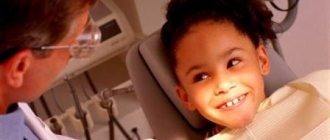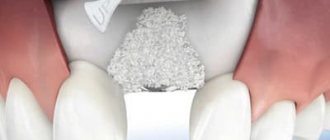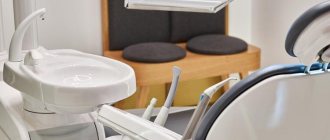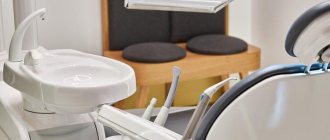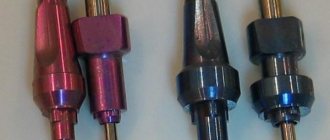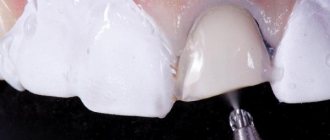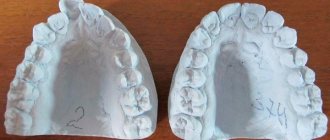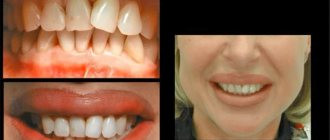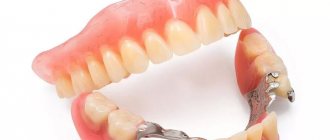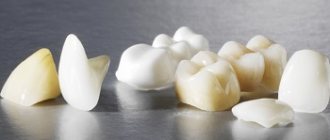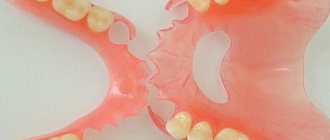The most popular classification of prints according to E.I. Gavrilov . It was based on the following basic principles. 1. The principle of the sequence of laboratory and clinical techniques for the manufacture of prostheses. On this basis, a distinction is made between preliminary (indicative) and final impressions. Preliminary impressions are taken with a standard spoon. Diagnostic models of jaws are cast from them, allowing one to study the relationships of the dentition, alveolar ridges of edentulous jaws, the relief of the hard palate and other features that are important for making a diagnosis, drawing up a plan for preparing the oral cavity for prosthetics, and the prosthetics plan itself. The same technique allows you to determine approximately the border of the prosthetic bed and make an individual tray . Based on the final impressions, a working model is cast.
2. A method of designing the edges of the impression, allowing the prosthesis to have a closing circular valve that provides one degree or another of its fixation. In accordance with this, anatomical and functional impressions . According to the method of edge design E.I. Gavrilov subdivides functional impressions , designed using: a) passive movements; b) chewing and other movements; c) functional tests. between anatomical and functional impressions . Essentially, there are no purely anatomical impressions. When taking an impression with a standard spoon, when forming its edges, they always use functional (though not sufficiently substantiated) tests. On the other hand, the functional impression represents a negative reflection of the anatomical formations (palatal ridge, alveolar tubercle, transverse palatal folds, etc.), which do not change their position during movements of the lower jaw, tongue and the functions of other organs. Therefore, it is completely natural that a functional impression has signs of an anatomical one, and vice versa. 3. The degree of pressure or the degree of squeezing of the mucous membrane.
According to the degree of its pressing, functional impressions are divided into:
1) compression or obtained under pressure, which can be arbitrary, chewing, dosed;
2) differentiated (combined);
3) decompression or obtained at minimum pressure.
Under any clinical conditions, only a functional impression using an individual tray.
Individual spoons can be made from : 1) metal (steel, aluminum) by stamping; 2) plastics: a) base (fluorax, ethacryl, yarocryl) by polymerization method; b) quick-hardening (redonta, protacryl) using the free-forming method;
c) standard plastic plates AKR-P; d) light-curing plastic; 3) solar-cured materials with polymerization in special chambers or using a solar lamp; 4) thermoplastic impression masses (Stens); 5) wax. Individual spoons are made in the laboratory or directly in front of the patient.
Making an individual plastic spoon in the laboratory.
In this case, an anatomical cast is taken with a standard spoon and a plaster model is cast from it. On the model, the dental technician draws the boundaries of the future individual tray . On the upper jaw, the border of the tray passes from the vestibular side along the transitional fold, not reaching the deepest point of its arch by 1-2 mm. On the distal side, it overlaps the maxillary tuberosities and runs along line “A” behind the palatine fossae by 1-2 mm. On the lower jaw, the border of the spoon passes from the vestibular side along the transitional fold, not reaching 1-2 mm to the deepest point of its arch, while bypassing the cords and frenulum of the lip. In the retromolar region, it is located behind the mucous tubercle, overlapping it by 1-2 mm. On the lingual side, the border of the spoon overlaps the area corresponding to the retroalveolar region (muscleless triangle), not reaching the deepest place of the sublingual space by 1-2 mm and going around the frenulum of the tongue. From the above it is clear that on both the upper and lower jaws the border of the individual tray is 2-3 mm less than the borders of the prosthesis. This is done so that there is space left for the impression material. The extruded impression material forms the edges of the impression. And, conversely, the distal boundaries of the tray must be larger than the boundaries of the prosthesis so that the anatomical formations, which are landmarks of the distal edge of the prosthesis, are well imprinted when taking an impression.
After drawing the boundaries, the dental technician coats the model with Izokol insulating varnish and begins making an individual tray from quick-hardening or base plastic. To make an individual spoon from quick-hardening plastic, the required amount of material is kneaded to a dough-like stage and a plate is made from it in the shape of the upper or lower jaw, which is pressed onto the model along the outlined boundaries. Then small pieces of plas are used to make a handle perpendicular to the surface of the spoon, rather than tilted forward. This position of the handle will not interfere with the design of the edges of the print. If the alveolar part of the lower jaw is significantly atrophied and the spoon turns out to be narrow, then the handle is made wider, almost up to the premolars: with such a handle, the doctor’s fingers will not deform the edges of the impression when they hold it on the jaw. After the plastic has hardened (10-15 minutes), the spoon removed from the model and processed with cutters and carborundum heads ( the individual spoon is not polished), making sure that the edges of the spoon correspond to the boundaries marked on the model. The thickness of the edge of the spoon should be at least 1.5 mm, because With a thinner edge, it is difficult to obtain the volume of the edge of the print. An individual spoon can be made from base plastic using the polymerization method. To do this, the heated wax plate is pressed tightly onto the model, giving it the shape of an impression tray, and excess wax is cut off with a spatula along the marked boundaries. The wax mold of the spoon is plastered into the cuvette in the reverse way and the wax is replaced with plastic. When making a spoon from AKR-P plastic, standard plates are softened in hot water and crimped according to the model. The excess is cut off with scissors after the corresponding area has been softened. The handle is made from scraps of material and glued to the spoon with a hot spatula (the heat melts and welds the plastic).
Individual spoons made of plastic are classified as rigid spoons. They can be used, as well as thermoplastic trays, to take compression impressions. Advantages and disadvantages of custom plastic impression trays . Plastic spoons are rigid and do not deform in the oral cavity, but, like any laboratory-made spoons (in two visits), they require subsequent correction in the oral cavity. In addition, spoons made in this way provide a modified display of soft tissues, because they are compressed and stretched during the taking of the anatomical impression.
Individual wax trays for the upper and lower jaws
Individual wax spoons can be made either in the laboratory or directly in the mouth. Wax trays using the CITO method are made in one visit directly on the jaw of the prosthetic patient. Such spoons are more accurate than individual ones made from an anatomical cast, because they display the soft tissues of the prosthetic bed at rest. The disadvantage of such trays is that the soft wax is deformed during fitting in the oral cavity and when taking an impression (it cannot withstand pressure), so the wax spoon can only be used to remove decompression impressions. Individual spoons , regardless of the method and material they were made from, must be placed in the oral cavity. A correctly fitted spoon sticks to the jaw and does not lag behind it when moving the lips and cheeks. , the technique of fitting individual spoons using Herbst functional tests has become widespread Functional Herbst tests are recommended when fitting individual trays and obtaining functional impressions .
Five tests are used on the lower jaw:
1) swallowing and wide opening of the mouth;
2) movement of the tongue to the sides along the red border of the upper and lower lips;
3) touching the cheeks with the tip of the tongue with the mouth half closed;
4) movement of the tip of the tongue forward beyond the lips towards the tip of the nose;
5) pulling the lips forward. Three tests are used on the upper jaw:
1) wide mouth opening;
2) cheek suction;
3) shifting the lips forward (pulling).
Obtaining a functional impression.
After fitting an individual tray, they begin to obtain a functional impression.
Obtaining an impression consists of the following steps:
1) fitting an individual spoon;
2) applying the impression mass to the tray;
3) inserting a spoon with the mass into the oral cavity;
4) forming the edges of the impression and conducting functional tests;
5) making an impression and evaluating it. It should be accepted as a rule that a functional impression that ensures good fixation of the prosthesis can only be obtained if the anatomical impression reflects all the structures of the prosthetic field and some functional features of the tissues surrounding the prosthetic bed. When a functional impression , they are only refined. There are unloading or decompression and compression impressions. Typically, the value of a compression or relief impression is associated with the fixation of the prosthesis and its effect on the mucous membrane of the prosthetic bed. However, the value of a particular impression-taking technique is determined by the influence of the prosthesis on the course of the process of atrophy of the alveolar process. Unloading (decompression) impressions are obtained without pressure or with minimal pressure of the impression mass on the tissue of the prosthetic bed. The disadvantage of the unloading impression is that the buffer zones of the hard palate are not subject to compression, and all the pressure from the prosthesis is transferred to the alveolar process, increasing its atrophy.
When receiving a decompression impression, the impression material must reflect every detail of the oral mucosa without distortion so that the microrelief of the prosthesis base exactly matches the surface structure of the prosthetic bed. Therefore, such impressions can only be obtained using impression compounds that have high fluidity and do not require much effort to remove the impression. Such masses include low-viscosity silicone pastes: exaflex, xanthoprene, alfazil, as well as zinc oxide eugenol pastes. The impression obtained using liquid plaster (according to Brachman) usually provides just such a perception of the surface relief of the tissues of the prosthetic bed. Some authors believe that if several holes are drilled in the impression tray to drain excess impression material, then the pressure of the impression mass on the mucous membrane can be reduced. It is known that the fixation of prostheses made using decompression impressions is weak, but they can be used if there are certain indications.
Such indications include:
1) significant or complete atrophy of the alveolar processes and mucous membrane;
2) increased sensitivity of the mucous membrane;
3) uniformly pliable mucous membrane of the prosthetic bed. Compression impressions are designed to take advantage of the pliability of the mucous membrane, so they are removed under high pressure to compress the buffer zones. When they talk about a compression impression, they primarily mean compression of the vessels of the prosthetic bed. The decrease in tissue volume and its vertical compliance are directly dependent on the degree of filling of the vascular bed. The use of compression impressions is recommended in the presence of loose mucous membranes with good pliability.
A prosthesis made using a compression impression does not load the alveolar ridge; outside of chewing, it rests only on the tissues of the buffer zones, like pillows. When chewing, under the influence of masticatory pressure, the vessels of the buffer zones are emptied of blood, the prosthesis settles somewhat and transfers pressure not only to the buffer zones, but also to the alveolar part. Thus, the alveolar process is unloaded, which prevents its atrophy. A prosthesis made using a compression impression has good fixation, because the pliable mucous membrane of the valve zone is in closer contact with the edge of the prosthesis. The compression impression is taken under continuous pressure , which ensures compression of the vessels of the mucous membrane of the hard palate and their emptying. To obtain such a print, certain conditions must be met:
1) you need a hard spoon;
2) the impression must be taken using a low-flow mass or thermoplastic mass;
3) compression must be continuous, stopping only after the mass hardens. Continuity can be ensured by manual force (voluntary pressure). But it is more convenient and correct to take a compression impression under the chewing pressure of the muscles that elevate the mandible, i.e. under bite pressure, which is created by the patient himself, or with the help of special devices that make it possible to create a strictly defined pressure (dosed) taking into account the individual characteristics of the tissues of the prosthetic bed and masticatory muscles. To obtain a functional impression, thermoplastic materials are used, such as dentofol, otrokor, orthlast, etc.
The convenience of using thermoplastic masses is explained by their following properties: 1) they have an extended plasticity phase, which allows for functional tests necessary to obtain a high-quality impression;
2) during impression taking they always have the same consistency; 3) they do not dissolve in saliva; 4) distribute pressure evenly; 5) allow you to repeatedly insert an impression into the oral cavity and carry out correction, because new portions of the mass merge with old portions without deforming the print. However, thermoplastic masses have certain disadvantages. These include: inaccurate print due to low fluidity; deformation in the presence of retention points. When cooled with water, they harden unevenly and may become deformed when removed from the mouth. It should be recognized that when using the above methods for obtaining an impression, in some cases it is not possible to ensure a complete functional reflection of the prosthetic field. The tissues of the prosthetic field and the active muscles surrounding it are not the same in relief, relative volume, physiological status during chewing or speaking, as well as during the day. The physical and emotional state of a person also has a great influence on the condition of the prosthetic bed and the surrounding muscles. Whatever method of taking an impression is used, further adaptation of the prosthesis base to the tissues of the prosthetic field, the relationship of the dentition and the force of chewing pressure is necessary, as well as adaptation of the patient and fitting of the prosthesis over a certain period of time. The wide variety of clinical conditions encountered for prosthetics necessitates the use of a differentiated impression. We should proceed from the general position that there is no single method shown in all cases. In this regard, the method of obtaining an impression in each specific case must be chosen taking into account the patient’s age, constitutional and individual characteristics of the jaw tissues, i.e. in all cases a differentiated approach is required. In cases where the tissues of the prosthetic bed in different areas are not identical in their relief and structure, the biophysical properties of each element of the prosthetic bed should be taken into account. When taking an impression, tissues with pronounced spring properties should be under greater load, while tissues of unloaded zones (in the area of the torus, incisive papilla, etc.) should not be overly loaded. Selective pressure on the underlying tissues, depending on their anatomical and functional characteristics and biophysical properties, may be important due to the need to prevent premature atrophy of the soft and bone tissues of edentulous jaws by redistributing the chewing pressure of the prosthesis base. Consequently, depending on the anatomical and physiological characteristics of the prosthetic bed, it is possible to obtain images of the mucous membrane in various functional states. At the same time, it is recommended to obtain unloading impressions in case of thin, atrophic and excessively pliable (“dangling” ridge) mucous membrane. Compression casts are indicated for loose, highly pliable mucous membranes. The best effect can be achieved only by using differentiated casts obtained with different degrees of compression of the mucous membrane, taking into account its compliance in different areas of the prosthetic bed.
Implantology is one of the most promising areas of development of modern dentistry. Prosthetics using dental implants is the most functionally and aesthetically effective method of replacing dentition defects [8]. The introduction of dental implants into clinical practice as supporting elements of orthopedic structures can reduce the use of removable dentures or significantly improve their fixation in the oral cavity [38].
The absence of internal stresses and the precision of the structures on the abutments of osseointegrated implants are 2 of the most important factors in ensuring the longevity of fixed implant-supported prostheses. Fulfillment of these conditions allows not only to guarantee the passive fit of the structure, but also to prevent the formation of microgaps between its internal surface and the abutments of the supporting implants [36]. The presence of such gaps leads to the fact that, under the influence of functional loads, the prosthesis begins to perform oscillatory movements with a gradually increasing amplitude, which can ultimately lead to breakage of the fixing screws. Without an accurate impression, it is almost impossible to achieve precision quality of an orthopedic design [26, 57]. Increased requirements for the accuracy of fit of implant-supported prostheses are due to the fact that, unlike natural teeth, there is no periodontal ligament around osseointegrated implants and therefore they have practically “zero” physiological mobility [59].
The challenge of taking impressions to make implant prostheses is to find technologies that can reproduce the soft tissue around the implants along with a three-dimensional image of the implant itself. It is necessary that the structure of the working model reflects as accurately as possible all the individual features of the current clinical situation and conveys as accurately as possible the positions of the laboratory analogue of the implant corresponding to the position of the implant in the patient’s jaw, eliminating the possibility of medical error at this stage of manufacturing dentures [5]. Only a high-precision impression makes it possible to obtain plaster models that have minimal dimensional errors and make it possible to produce a high-quality denture [40].
One of the important aspects when taking impressions on implants is also a clear display of the mucous membrane of the perigingival part (in the marginal gingiva area) [7, 63]. To obtain a highly aesthetic orthopedic design for implant-supported prosthetics, the connection of the crown with the superstructure must be located submarginally, within the free gum [30].
Currently, methods of immediate implantation after tooth extraction have emerged, in which there is a need to obtain an accurate impression immediately after the operation of implant installation [38]. Impression materials must be bioinert to exclude pathological changes; they must have specific properties, the most important of which are sterility and lack of cytotoxicity. In such cases, when choosing an impression material and a method of taking an impression, the goal of this stage of prosthetics should be taken into account - to achieve maximum accuracy and reduce time costs [45].
When taking impressions of prepared teeth and implants at the same time, new challenges arise. The precision of the impression is expressed primarily in the accurate and detailed representation of the finest structures in the area of the periodontal sulcus [12]. In order to correctly produce the edge of the crown, it is necessary to obtain a clear image of this area on the impression [2, 3, 10].
To obtain impressions for implant-supported prosthetics, the most widely used impression materials are from the group of anhydrous elastomers—polyester and A-silicone [9, 25, 26, 43, 47, 49, 65, 66]. The great practical importance of viscosity for impression materials explains the principle of their classification. According to ISO 4823:1992 they are classified into materials of high, medium and low viscosity. The revised ADA specification No. 19 added a very high-viscosity type [22].
Polyester materials perfectly reflect the relief of the tissues of the prosthetic bed. Their main advantage is their pronounced hydrophilicity, which is important, since it is not always possible to achieve dryness of the reproduced surface [1, 29]. Polyesters exhibit very little linear shrinkage, since the polymerization reaction occurs as a polyaddition, i.e. without releasing any by-products. Superior to A-silicones and C-silicones in terms of volume recovery after deformation (99.6%), polyester materials can be successfully used even in the presence of significant undercuts without the need for additional blocking of the latter [27, 55]. However, the impression is quite rigid and difficult to remove from the oral cavity [13].
Currently, new automatic mixing systems are used to mix the main and catalytic masses to prevent the formation of bubbles. At the same time, mixing time is significantly reduced: about 30 s is required to fill a medium-sized impression tray [17].
During disinfection, polyesters actively absorb moisture, and during storage they adsorb it, so prints change their dimensional accuracy. To avoid deformation of impressions, they must be stored dry [22, 56]. It should be borne in mind that catalyst paste can sometimes cause an allergic reaction [51]. M. Ree (2001) described a case of inflammation of the marginal gingiva caused by a fragment of polyester material stuck in the gingival sulcus [62].
Many authors have determined the cytotoxicity of polyester impression materials [44, 64, 70]. It is emphasized that, despite significant toxicity, the influence of the impression material in the clinic is small, its contact with oral tissues is very brief, and toxic molecules cannot easily penetrate the barrier membranes of the mucous membrane during hardening when taking an impression.
In implant-supported prosthetics, A-silicone impression materials are also widely used, which have a combination of qualities that best meet all the requirements for impression materials [15]. Numerous clinical data indicate the high quality of models obtained from impressions from these materials [32, 61]. Additive silicones offer the highest quality of detail reproduction due to a well-balanced combination of fluidity and structural viscosity. In addition, they are dimensionally stable, since the polymerization reaction occurs without the release of by-products, which causes minimal shrinkage of the material [26].
A-silicones are tasteless and odorless, have sufficient tensile strength and elasticity, are characterized by optimal compatibility with the skin and mucous membrane of the oral cavity, which makes them well tolerated by patients, restore volume after deformation when removed from the oral cavity by 99.84% , thixotropic, pressure-resistant, and have good layer-by-layer bonding [28, 34, 35]. A-silicones are hydrophobic, therefore, to impart hydrophilic properties to them, polyester components or surfactants are additionally introduced [54].
Among the disadvantages of A-silicone impression materials are: the negative effect of latex gloves on the speed and quality of polymerization, poor adhesion to the impression tray (this problem is solved by applying a special adhesive composition (adhesive) to the impression tray). Hydrogen peroxide, anesthetics, and retraction solutions inactivate the catalyst; it is necessary to work in a thoroughly washed and dried oral cavity [25, 32].
There are various options for classifying impressions according to the method of their production, proposed by domestic [5, 6, 32] and foreign scientists [49]. One of the latest classifications proposed by A.N. Ryakhovsky (2002), takes into account the stages of obtaining the print and the number of layers that make up the print. According to this classification, among modern methods of obtaining an impression using elastic materials, one-stage and two-stage methods are distinguished. In a one-stage impression taking, a tray with impression material is applied once and after removing it from the oral cavity, the impression is sent to the laboratory. In the two-stage method, the impression is taken one by one: first with the base mass, and then, after structuring it to clarify the details of the prosthetic bed, the resulting impression is reapplied, adding corrective material. In implant-supported prosthetics, a one-stage (single-layer or two-layer) method is mainly used [11].
The single-phase impression technique is the most common. For one-stage monophase impression, the materials belong to the group of medium- and viscous-flow, the authors give preference to polyester mass [27]. This method reduces material consumption and reduces time spent at the stage of obtaining an impression. However, such an impression will not provide a clear image of the subgingival part of the prosthetic bed, since there is no dynamic movement of the impression mass under the gum, which deteriorates the quality of the impression during simultaneous prosthetics on implants and natural teeth. In such cases, it is necessary to individualize the impression tray as much as possible [12]. The best result is observed when adding a mass of material into a tray, and additionally from a syringe directly into the periodontal groove [21].
The “sandwich technique” of taking impressions from installed transfers is not much different from a similar technique in classical orthopedic treatment. The work must be done “with 4 hands”. With a one-stage, two-layer impression, no elastic deformation of the base layer occurs. In the case of closely spaced transfers, as well as when visible undercuts are detected between the transfers and the gingival margin, it is necessary to cover the transfer with a corrective layer and fill the undercuts in excess to prevent the accumulation of air bubbles that prevent the penetration of the base layer [33]. To take two-layer impressions, impression materials having several degrees of viscosity are used. Of particular importance is the balance of material characteristics for the first and second layers [1].
The shape and size of the impression tray are determined by the shape of the jaw, the width of the dentition, the topography of the defect, the height of the crowns of the remaining teeth, and the severity of the edentulous alveolar process. A well-selected tray makes it easier to obtain an impression, and the more complex the conditions for obtaining it, the more carefully the tray should be selected [24, 53].
There are standard and individual impression trays. Using a standard impression tray, the impression is taken with base and corrective layers of silicone or polyester materials using the standard “sandwich impression” technique. An example of a standard tray is the Wintray, which has segments in the occlusion area corresponding to the location of the implant, which can be removed by unscrewing the fastening bolt. This tray cannot be used if the angle of inclination of the implant is greatly increased.
In most cases, in implant-supported prosthetics, a custom impression tray is used [4]. An individual impression tray differs from a standard one in that it makes it possible to obtain a uniform impression material thickness, taking into account the structural features of the patient’s oral tissues. The uniformity of the thickness of the print, in turn, guarantees against noticeable distortions and reduces material costs, and also gives a more accurate print that matches the original [39]. It has been established that impressions obtained using individual impression trays are more accurate compared to impressions using standard trays [16, 18, 58, 69].
Individual trays are made in the mouth or in a dental laboratory from plastic using various methods: manual molding, pressing, casting, light-curing, vacuum-temperature stamping. Materials for the manufacture of individual spoons can be metal (steel, aluminum), self-hardening plastic, hot-curing plastic, light-curing plastic, wax, thermoplastic plastic [13, 32].
The most widely used are individual trays made of self-hardening plastic, manufactured in a dental laboratory according to a model obtained using a preliminary impression taken with a standard impression tray (free molding method on a plaster model) [8]. However, this method cannot be considered promising, since significant deformations are observed that distort the surface macrorelief; the edges of the spoons very often move away from the boundaries in the region of the transition fold [20]. In this case, the inaccuracy is compensated for relatively effectively by impression compounds. Light-curing (or photo-curing) wafer-shaped resins that follow the shape of the upper or lower dentition for impression trays are an excellent alternative to self-curing materials because the impression tray can be fully formed from these materials before curing with ultraviolet light. The disadvantages of such an individual spoon during the period of its fitting include: increased hardness associated with the structural characteristics of light-polymerizing materials; the fact that when grinding the edges of the spoon, a significant amount of fine dusty mass is formed, which makes it difficult to fit the spoon; the need for ultraviolet light curing equipment, an ultraviolet light chamber; higher cost of photocurable material [20, 23].
The thickness of the impression material, which is established using a layer of wax, must be uniform. Gordon (1990) et al. suggested an impression material thickness of 3 mm [50], Smith et al. (1999) - 1.5 mm [68], Castellani et al. (1997) - 1.5-2 mm [42]. Ortensi (2000) suggests that this thickness should be 3–4 mm [60]. Tjan et al. (1997) believe that the thickness of the material does not affect the accuracy of the impression [71]. R. Marchkors (2006) states: in order to avoid plastic deformation, the thickness of the impression material should be 4 times the depth of the undercut [57].
In the clinic, taking impressions for implant prosthetics is a complex process that includes a number of subjective variations of the technique, taking into account the characteristics of each clinical case [73].
These features include: variants of the anatomical structure; number and location of implants; implant divergence; numerous elements of implant designs; accuracy of impression materials and process hardware. Today there are more than 500 implantation systems in the world, and each of them has its own distinctive features and characteristics. Depending on the type of implantation system, impression taking technologies may vary. A special device for transferring the spatial position of the implant to the model is an impression transfer. It usually consists of 2 parts: the actual impression part and the screw. Sometimes radiographic control is necessary to confirm that the transfer has been properly seated [15]. Phillips et al. (1994) believe that giving the impression coping a rectangular shape allows a statistically significant reduction in the amount of dimensional deviation and distortion, which are higher with conical copings.
There are 3 standard methods for obtaining impressions used in dentistry [40]:
- prepared abutment; an impression of the abutment(s) is taken directly in the patient's mouth, in the same way as when taking impressions for traditional fixed prosthetics; impressions of the prepared abutment are always obtained using a closed tray [31];
— an impression at the implant level is obtained using a special carrier (transfer), which is fixed directly to the implant; such a transfer allows you to convey the location and inclination of the implant;
— an impression at the abutment level, which is used for the subsequent manufacture of a screw-retained structure; special transfers are installed on abutments pre-fixed to the implants; This impression allows you to display the location and inclination of the screw-retained abutments.
Impressions taken at both the abutment and implant levels can be made using one of the following techniques: closed tray, i.e. indirect method; transfer method, or open spoon, i.e. direct method or capture method.
Indirect transfer transfer method. This technology is used mainly for prosthetics on single implants, but can also be used for the manufacture of an individual open impression tray and for the manufacture of temporary dentures [59]. When taking an impression with a closed tray, the indirect transfer remains in the oral cavity after removing the impression from the oral cavity. The transfer is then removed and connected to the implant replica and carefully placed into the appropriate hole in the impression. At the same time, resistance is felt and a click is heard, which indicates a correct fit; there should be no mismatch [31]. Additional transfer of the transfer from the oral cavity to the finished impression causes errors. If it is difficult to remove the impression tray with the impression material from the oral cavity, the true position of the impression coping may be disrupted, and errors may occur as a result of tilting, rotation and displacement along the axis of the impression copings [4, 46]. The greater the residual deformation of the impression material, the less retention of the indirect impression coping and the more its position in the impression changes [59]. Vigolo et al. (2003) suggest sandblasting the surface of the cap and then applying an adhesive for impression material to its surface, which will eliminate distortion as a result of possible rotational movements [72].
The direct method of transfer transfer is used for prosthetics on 1 or several implants. Taking impressions with an open impression tray is the most common technique. Almost all implantation systems have a system of direct impression transfers from the implant or its abutment [33]. The method allows both to register the location of the implants and to display the contour of the soft tissues. When using an open tray, the transfer remains in the impression after the latter is removed from the oral cavity [14]. To obtain an impression using this method, it is necessary to make an individual impression tray or modify the standard one so that there are holes in the projection of the implants for unhindered insertion of screws. The transfer should not come into contact with the edge of the spoon and interfere with its free movement. Therefore, the perforation hole must be formed with an excess of 5 mm for each installed transfer. In case of multiple implants, it is better to make 1 window for all transfers [31]. The outside of the window should be covered with soft wax to prevent leakage of the impression material when filling the tray [40].
The screws that secure the open tray transfers during the impression making stage are removed through the holes in the tray after the material has hardened. Then the impression is removed from the oral cavity along with the transfers located in it. After this, analogues of the implants are attached to the transfers located in the impression and a working model is cast from plaster, the location of the analogues in which completely corresponds to the position of the implants in the patient’s oral cavity.
When implants have divergence, the use of a closed tray technique is practically impossible; The open tray method allows the impression to be removed from the oral cavity along with transfers, which eliminates deformation and damage to the impression material [11, 47, 59]. However, this technology of taking an impression is more labor-intensive and requires more attention from the dentist.
The direct method gives the best results, although its use is not always possible. In restless patients or patients with a tendency to bleed, it is better to first evaluate the possibility of using the direct method of taking an impression, since it requires keeping the impression tray in the mouth longer [40].
When there are 2 or more implants, the main task is to ensure immobility of the impression copings, which is achieved by connecting them [28]. A piece of wire, floss, or retraction thread can be used as a frame between transfers. The transfers are then splinted with self-hardening plastic. If there is a large distance between the implants, the dental technician can prepare the plastic on transfers using a pre-cast model, after which the plastic is sawed, and the model with splinted transfers is sent to take an impression. This avoids distortions that occur during plastic polymerization [48]. There is evidence that patients are able to feel the effect of shrinkage pressure during acrylic bonding of transfer copings inside the mouth [41].
C. Hsu et al. (1993) compared the accuracy of implant placement between transfer impression techniques using plastic splints, ordontic wires and without splinting when using polyester impression materials [52]. No difference was found between the listed techniques, so it was assumed that the use of splinting is not necessary. D. Assif et al. (1996) believe that with splinting the results are better than without it [37].
It will probably be possible in the future to scan oral tissues using an optical, mechanical or laser reader to obtain data necessary for prosthetics, but at present the use of impression materials remains a necessary step in prosthetics [67].
In connection with the increasing requirements for the aesthetics and functionality of dentures, the attitude towards impressions moves to a qualitatively different level [19].
An analysis of literature data suggests that taking an impression during implant-supported prosthetics is a pressing, but not fully understood, problem.
An algorithm for selecting an impression material and a technique for making impressions taking into account a specific clinical situation has not yet been developed.
Further work in this direction should be aimed at creating a unified approach to the selection of material and the method of obtaining an impression for implant-supported prosthetics, which would allow the doctor to apply the optimal option for orthopedic treatment.
